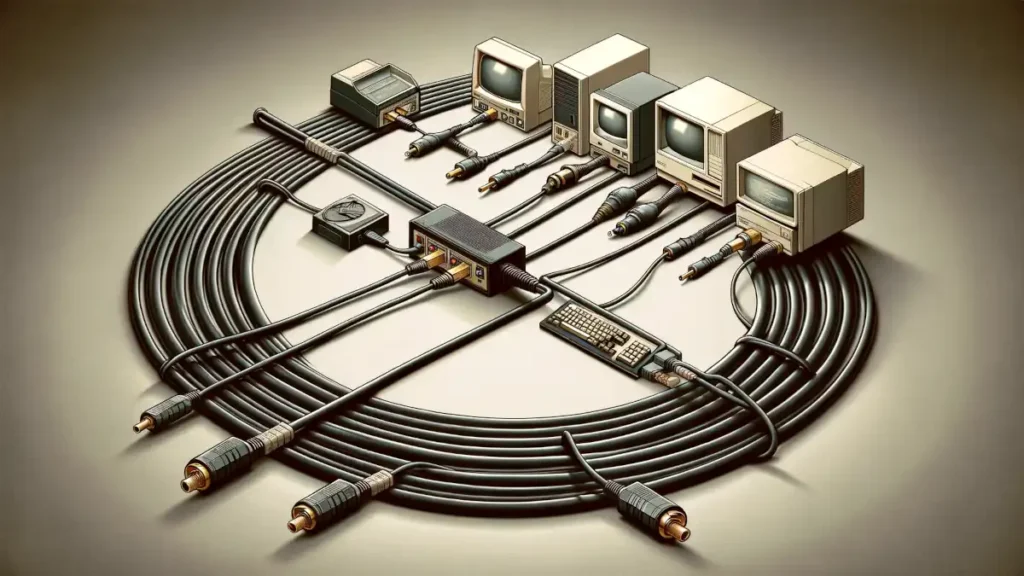
In the realm of computer networking, understanding various topologies is key to grasping how networks are structured and function. Among these, Bus Topology stands out for its simplicity and historical significance. This article aims to demystify Bus Topology, delving into its core principles, advantages, limitations, and its evolution in the networking landscape. We’ll navigate through its conceptual framework, practical applications, and reasons for its decline in favor of more advanced topologies. By the end of this exploration, you’ll have a comprehensive understanding of Bus Topology and its place in the history and future of network design.

Bus Topology, in the context of network design, is not just a concept but a physical topology. This distinction is crucial as it refers to the actual layout of the network – how devices are physically connected and the tangible structure it takes. Understanding physical topology is fundamental, as it dictates the network’s performance, capabilities, and limitations.
The term physical topology refers to the way in which a network is laid out physically. Two or more devices connect to a link; two or more links form a topology. The topology of a network is the geometric representation of the relationship of all the links and linking devices (usually called nodes) to one another.
Behrouz A. Forouzan, “Data Communications and Networking” (1)A network that uses a bus topology is referred to as a “bus network.” Bus networks were the original form of Ethernet networks, using the 10Base5 cabling standard.

In a Bus Topology, when a device transmits data, the signal travels along the bus until it reaches every connected device. Each device examines the signal and determines if it’s the intended recipient. If not, the device ignores the data. This process continues until the data reaches its destination. However, if two devices send data simultaneously, it leads to a collision, disrupting the network communication.
While Bus Topology is efficient in certain contexts, it has limitations, especially in scalability and collision management. As the network grows, the risk of data collisions increases, and the bus becomes a bottleneck, limiting the overall network performance.
In summary, understanding Bus Topology is vital for grasping fundamental networking principles. Its simplicity and cost-effectiveness made it popular in early network designs, setting the stage for more complex topologies. However, its limitations in handling larger, more demanding network environments led to its decline in favor of more robust alternatives.
The concept of Bus Topology originated in the early days of computing and networking. It was a brainchild of the collaborative efforts of multiple researchers and engineers striving to simplify network communication. The exact origins of Bus Topology are diffuse, as it evolved through collective innovation rather than a single inventor’s breakthrough. However, its roots can be traced back to the development of early computer networks in the 1960s and 1970s, particularly the pioneering work on Ethernet technology by Robert Metcalfe and David Boggs at Xerox PARC. (2)
In its infancy, Bus Topology was revolutionary, offering a simple yet effective way to connect multiple computers. Its adoption was accelerated with the advent of Ethernet technology in the 1970s, which utilized a bus layout for connecting devices within a Local Area Network (LAN). Ethernet’s standardized approach to networking and its use of Bus Topology played a pivotal role in the topology’s widespread adoption.
Over time, Bus Topology underwent several refinements. The introduction of terminators at each end of the bus cable helped reduce signal reflection and improve data transmission efficiency. Furthermore, advancements in cable technology, like the shift from coaxial cables to more efficient and reliable alternatives, marked significant milestones in the evolution of Bus Topology.
Despite its early success, Bus Topology began to face challenges as network demands grew. The topology’s inherent limitations, such as difficulty in troubleshooting, vulnerability to cable failures, and inefficiency in handling network traffic in larger setups, became more pronounced. The late 20th century saw a gradual shift towards more robust topologies like Star and Ring, which offered greater scalability, reliability, and ease of maintenance. This shift marked a decline in the use of Bus Topology in mainstream networking, relegating it to niche applications or as a foundational concept in networking education.
Choosing the right network topology is crucial for building efficient and reliable networks. Alongside Bus Topology, other common topologies include Star, Ring, Mesh, and Hybrid. Each topology has its unique attributes and is suited for different network requirements.
Star Topology, one of the most prevalent in modern LANs, features a central connection point, typically a network switch or hub, to which all network devices are connected. Its key advantages include high reliability – a failure in one cable only affects one node – and ease of setup and troubleshooting. However, it requires more cable than Bus Topology and is heavily dependent on the central hub’s functionality.

In Ring Topology, each device is connected to two others, forming a closed loop. Data travels in one direction, passing through each device. While it’s efficient in handling data traffic and easy to install, its reliance on the uninterrupted loop makes it vulnerable to disruptions if a single connection fails.

Mesh Topology is characterized by its robustness, with each node directly connected to multiple others. This setup enhances fault tolerance and offers multiple paths for data transmission, making it ideal for critical applications. However, its complexity and high cabling requirements can be cost-prohibitive.

Hybrid Topology combines elements of different topologies to leverage their strengths while mitigating weaknesses. It’s adaptable to varied network needs and scales but requires careful planning and management.

Selecting the right topology depends on factors like network size, scalability needs, budget, and fault tolerance requirements. For small networks with limited devices, a simple Star or Bus Topology might suffice. In contrast, large-scale or critical operations may benefit from the robustness of Mesh or Hybrid Topologies.
In conclusion, while Bus Topology laid the groundwork for network design, evolving technology and changing requirements have led to a diverse array of topologies. Understanding these options and their suitability for different scenarios is key to building effective and resilient networks.
While Bus Topology has its advantages, it also faces several challenges, particularly in larger or more complex network environments.
To mitigate these challenges, several strategies can be employed:

The decline of Bus Topology is closely tied to the evolving demands of network environments. During the late 20th century, as networks grew in size and complexity, the limitations of Bus Topology became increasingly apparent. Its inability to efficiently handle high traffic volumes and its vulnerability to single points of failure started to outweigh its simplicity and cost-effectiveness.
Today’s network topologies reflect the need for scalability, reliability, and adaptability. The rapid growth of the Internet of Things (IoT), cloud computing, and distributed computing environments has driven these changes.
The landscape of network topologies is continuously evolving to meet the needs of modern network environments. While Bus Topology laid the foundational principles, the focus has shifted towards more flexible, scalable, and reliable designs. Understanding these trends is crucial for network professionals and organizations aiming to build efficient and future-proof network infrastructures.
Bus Topology, a cornerstone in the history of network design, has played a crucial role in shaping modern networking concepts. Despite its decline in favor of more advanced topologies, understanding its principles, challenges, and solutions provides valuable insights into the fundamentals of network architecture. As technology continues to advance, the lessons learned from Bus Topology remain relevant, informing the development of more sophisticated and resilient network structures.
Your Comprehensive Guide to Computer Networking!